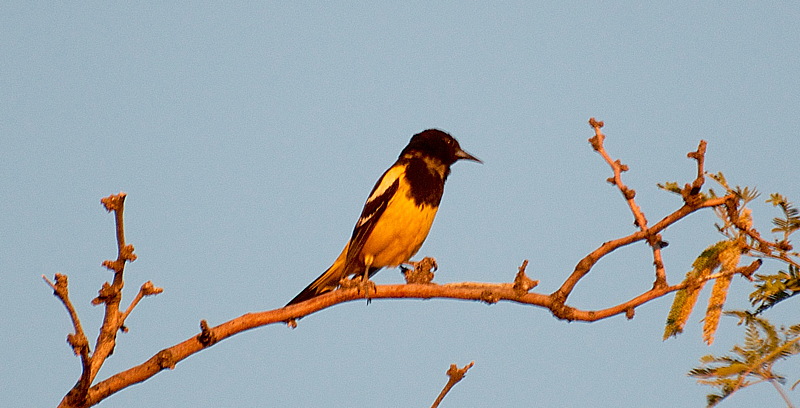
Critter, Contrail, Moon Video, Mercury and Venus
Posted: 20 June 2013
The observatory was opened Wednesday, 19 June 2013, at 1842 MST, 103°F. The sky was clear but there was a slight breeze blowing. At 1854 MST, I took a quick look at Venus with the 8" LX200-ACF, 83X. Then I went to Mercury. Its crescent phase was still clearly visible at 83X. Upped the magnification to 222X; the crescent phase was visible, although Mercury was faint and low contrast against the bright sunlit sky 40 minutes before sunset. I took a final look at Mercury at 1909 MST, and slewed the 8" to the waxing gibbous moon.
I then had a visitor:

While photographing the bird, I noticed a strange contrail in the eastern sky. I had not seen or heard any aircraft so wondered I wondered if it could have been from a meteor that occurred while I was still under the dome. The trail didn't spread out from upper atmosphere winds as I expected if it had been a meteor. But still, it was odd. These photos were taken at 1924 MST, 1926 MST, and 1928 MST:



At 1932 MST, I began setting up for prime focus imaging of the moon using the D7000 DSLR. This was to be a final test of HD video recording for next Tuesday's HST-Moon transit. On my previous successful HST-Moon transit imaging, I had used 1/2000sec, ISO 3200. My tests this night were to try to improve on the image quality by reducing the ISO value. I did several tests at 1/2000sec using various ISO values. During post-processing, I determined that ISO 2000 yielded the best image quality, brightness, and contrast. This is a single frame from the 1/2000sec, ISO 2000, HD video:

My recent reports have included HD videos that were slow to start playing. As a test, I'm using Vimeo to host the following video in the hope that it works better for viewing. Let me know in the comments section at the end of this page whether this video format works for you or not. Thanks.
HD video tour of the moon, prime focus, 1/2000sec, ISO 3200, 44 seconds. Click to play. You can also view the video full-screen by clicking the arrows in the lower right hand corner of the video.
Moon Tour PF 061913 from Mike Weasner on Vimeo.
If you prefer the old file download method, this is the full 40.6 MB HD video.
I also did some test HD video recordings of the craters Clavius and Tycho at prime focus + 3X TeleXtender. This is a single frame from a video, 1/250sec, ISO 2500:

Compare the above image to the one from the previous night taken at prime focus + 2X Barlow Lens. There is essentially no difference in the magnification in the two images. When used with an eyepiece, there is big difference (2X vs 3X) when using the 2X Barlow Lens vs 3X TeleXtender. However, when used at prime focus alone, there is no noticable difference.
Imaging was ended at 2005 MST. I did a quick tour of the lunar terminator at 222X. I then began closing up to avoid prime time for the Kissing Bugs.
The observatory was closed at 2019 MST, 83°F.
After leaving the observatory, I took this photograph of Mercury and Venus above the observatory dome, f/4.5, 1/25sec, ISO 1600, 70mm, flash:

Mercury is faint and to the left of Venus. Compare the above image to the one from the previous night. Mecury is getting lower in the western sky every evening.
Comments are welcome; use the Comments section below, or you can Email Me. Thanks.
Cassiopeia Observatory Home Page